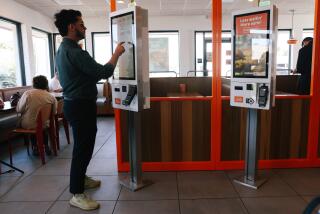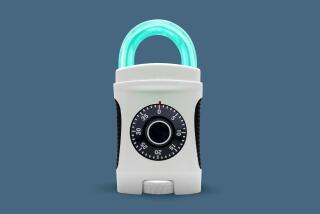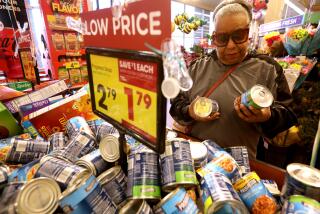Coupons Cut the Clipping : High-Tech Gadgetry Catapults Industry Into the 21st Century
- Share via
The clip-clip of coupon collecting is fast being replaced by the zip-zap of the computer.
Just when you thought consumer product makers had figured out every conceivable way to slip coupons into your newspaper, mailbox and hands, they’ve concocted a batch of new, high-tech gadgets that are catapulting the century-old promotional vehicles into the 21st Century.
Supermarket cash registers are dispensing coupons linked to what store computers “see” you have purchased. Store aisles are increasingly littered with plastic gadgets with flashing red lights that entice shoppers by automatically dispensing coupons on the spot.
Still to come, supermarket kiosks will “read” computer punch cards that give a rundown of your shopping list--and instantly emit coupons only for types of products you plan to buy.
This high-tech revolution is a far cry from the beginnings of the coupon industry a century ago, when the Post cereal company offered coupons worth a penny toward the purchase of Grape Nuts. But the stakes in the industry--which distributed 310 billion coupons last year--have never been higher.
After decades of growth, there are new signs that consumers are growing blase about coupons. Coupon distribution was down 12% and redemption was flat for the first quarter of 1993 compared to the year-earlier period, reports CMS Inc., a Winston-Salem, N.C.-based coupon research firm. Total coupon redemption totaled $4.6 billion in 1992, the same as the previous year.
“People are rather fed up with coupons,” said John Philip Jones, a marketing professor at Syracuse University. “Many consumers consider them quite a hassle.” People often leave their coupons at home or in the car, he said.
“The whole coupon industry has grown into a white elephant,” said Deborah Bozsa, vice president at the New York ad agency D’Arcy, Masius, Benton & Bowles, which just completed a study of the industry.
“It would be great if everyone offered low prices every day and coupons didn’t exist,” Bozsa said. “But I suppose that would be un-American.”
But there are strong reasons why some companies continue to use coupons instead of just giving discounts. Coupons are important for introducing new products, marketers say. Also, while most shoppers think they use coupons to save money, they actually use them because it makes them feel smarter.
“It’s a much bigger triumph than saving money,” said AmbujJain, a professor at Southern Methodist University in Dallas who has studied the psychology of coupon use. “That feeling of smartness is self-fulfilling. You cash in a coupon and the psychic benefit can be enormous.”
Coupons also encourage impulse buying. One in four consumers buys products he doesn’t even immediately need just to take advantage of coupon savings, said Joan Johnson, marketing services manager at CMS. And one-third of sales at Ralphs Grocery Co. involve coupons, said Al Marasca, president of the chain.
The challenge for the industry: how to make the coupon process a bit easier?
The vast majority of coupons--upward of 80%--are still distributed in Sunday newspapers. Yet only a fraction of African-American, Asian and Latino households receive mainstream papers, said Darryl Mobley, president of Sacramento-based MPI Coupon Distribution. “It’s not intentional,” he said, “but these groups are systematically excluded from using coupons.”
MPI recently began inserting coupons into 300 African-American newspapers nationwide, and it claims to now reach many of the nation’s black households. As a result, Mobley said, coupon use by African-Americans should increase over the next few years.
Experts contend the real growth area for coupons is inside the stores. And that’s why so many companies are battling to get their coupons placed inside supermarkets and drugstores.
Among the first was Anaheim-based Catalina Marketing, which 10 years ago began attaching its electronic scanners to supermarket registers. The machines automatically dispense coupons, but only in those product categories purchased by the shopper.
Now the company is testing a supermarket coupon checkout program that can actually “recognize” consumers by their driver’s licenses or check ID card numbers, and dispense coupons based on products that individual consumers have purchased in the past, said Tommy Greer, chief executive of Catalina.
For example, shaving cream is more likely to be purchased monthly than weekly. So the computer might wait several weeks after a consumer has purchased shaving cream before it dispenses a shaving cream coupon to the customer.
But Catalina executives insist the company isn’t spying on consumers. “We only know shoppers by their ID numbers, not their names,” Greer said.
For months, supermarket shoppers have been bumping into plastic coupon dispensers in store aisles at a number of major supermarkets and several drugstore chains. The object of these dispensers is to lure shoppers into impulsively buying products, said Wayne Locurto, president of Actmedia Inc., a Norwalk, Conn., firm that specializes in in-store ads.
Despite the $2 million that Actmedia spent to develop the machines, there have been some glitches. Kids are the biggest fans of the dispensers--some snatch coupons dozens at a time. So the company has put mechanisms on the battery-operated devices that automatically delay dispensing coupons--for up to a minute--if someone grabs more than one.
The talk of the coupon industry, however, is Max System--a metal kiosk developed by Atlanta-based Response Media Products in conjunction with Autotote ESP. The kiosk spits out coupons specifically linked to personal shopping lists placed by shoppers on computer punch cards sent to them at home or inserted into their grocery bags. It will be tested at half a dozen grocery chains early next spring.
“It’s no problem if you forgot your coupons at home, because Max gives them to you when you walk in the door,” said Jacqueline Granath, executive vice president at Response Media.
But human error can still play a role. Some people might leave their punch-card lists at home--along with their coupons.
Briefly . . .
Costa Mesa-based Salvati Montgomery Sakoda has picked up the $5-million ad account for Taylor Made Golf Co. of Carlsbad, formerly handled by Venice-based Chiat/Day. . . . Los Angeles-based Phelps Group has been selected by La Sala Holding Co. of Los Angeles to handle its ad account. . . . Glendale-based Baskin-Robbins is talking with agencies about its $8-million account, now handled by Asher/Gould of Los Angeles. . . . Hollywood-based Bertrand Advertising Agency has sold its recruitment division to New York-based Bernard Hodes Group. . . . RLR/Jarrin, the Latino marketing arm of Pasadena’s Robischon, Lacher & Rossman, has picked up the $1-million ad account for Prime Ticket’s Spanish-language sports cable network, La Cadena Deportiva.
What Coupon Clippers Buy
Nearly half of all disposable diapers and more than one-third of all cereals are bought with coupons. Here is a 1992 breakdown of the most popular product categories for coupon users:
Product % of sales bought with coupon Disposable diapers 43% Ready-to-eat cereals 35 Liquid detergents 29 Deoderants 25 Sanitary protection 24 Coffee 20 Pet food 12 Adult cold remedies 11 Carbonated beverages 8 Candy 7 Gum 2
Who Are Coupon Clippers?
Despite all the on-going demographic changes in America, there has been little change over the years in who uses coupons.
The typical coupon user is: * Female * 45 years old * White * Married * Employed full-time * High-school graduate (with some college) * In a household of three people * Spending an average of $74 a week on groceries * Is saving an average of $6 a week with coupons
Sources: Nielsen Clearinghouse and DMB&B; Media
More to Read
Inside the business of entertainment
The Wide Shot brings you news, analysis and insights on everything from streaming wars to production — and what it all means for the future.
You may occasionally receive promotional content from the Los Angeles Times.










